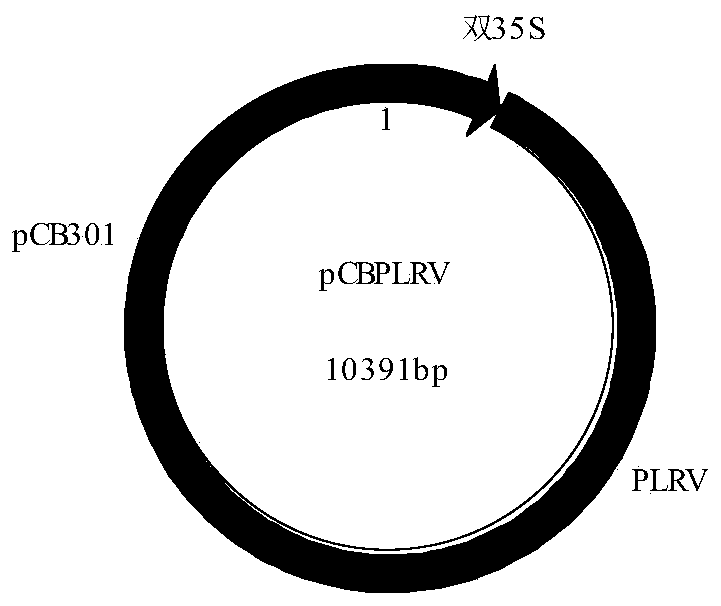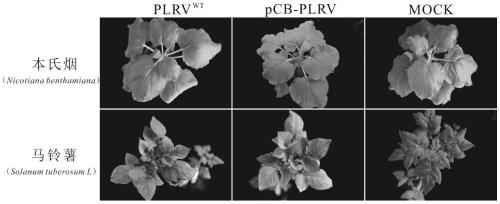Potato leaf roll virus infectious clone and construction method thereof
A leaf-roll virus and a construction method are applied in the field of plant genetic engineering and can solve the problems of reduced infectivity, unstable cDNA transfer, and difficulty in obtaining infective clones.
- Summary
- Abstract
- Description
- Claims
- Application Information
AI Technical Summary
Problems solved by technology
Method used
Image
Examples
Embodiment 1
[0045] Embodiment 1: the extraction of potato leafroll virus RNA
[0046] Total plant RNA was extracted using the TRIzol method, and the extraction method was referred to the description of the plant RNA extraction kit.
[0047] Take 0.1g of potato diseased leaves infected by potato leafroll virus, add it to a pre-cooled mortar, grind it into powder with liquid nitrogen, transfer it to a sterilized 1.5ml centrifuge tube, add 1mL TRIzol and shake vigorously for 30s. After incubating at room temperature for 5 min, 0.2 ml of chloroform was added, shaken vigorously for 15 s, and then incubated at room temperature for 3 min. After centrifugation at 10,000 g for 15 min at 4°C, take 0.5 ml of the upper aqueous phase into a new centrifuge tube, add 0.5 ml of isopropanol to mix by inversion, and incubate at room temperature for 10 min. Centrifuge at 10000g for 10min at 4°C to remove the supernatant, add 1ml of 75% ethanol and shake vigorously. After centrifugation at 7500g for 5 minu...
Embodiment 2
[0048] Example 2: Construction of Potato Leafroll Virus Infectious Clones
[0049] Using the viral RNA obtained in Example 1 as a template, reverse transcription was performed with random primers and primer 4. The reverse transcription reaction procedure is as follows:
[0050]
[0051]
[0052] Incubate at 65°C for 5 minutes, quickly place on ice to cool for 2 minutes, and spin off.
[0053]
[0054] 25°C, 5min; 50°C, 45min; 85°C, 5min to terminate the reaction. Using the obtained reverse transcription product (cDNA) as a template, use Phusion high-fidelity polymerase for PCR amplification. The PCR reaction system is as follows:
[0055]
[0056] Reaction procedure:
[0057]
[0058] The PCR product was subjected to 1% agarose gel electrophoresis, the gel was cut and recovered for future use, and the PCR product of the PLRV 1-3161bp fragment was obtained. Using primers 5 and 6 to amplify the pCB301 vector sequence, the annealing temperature was 60°C, and th...
Embodiment 3
[0059] Example 3: Determination of the infectivity effect of pCB-PLRV
[0060] The pCB-PLRV plasmid was transformed into Agrobacterium GV3101. After colony PCR verification, pick a single spot and inoculate it in liquid LB medium containing kanamycin (50 μg / mL) and rifamycin (50 μg / mL). Take 500 μL of the bacterial solution and add it to 5 mL of 10 mmol / L 2-(N-morpholine)-ethanesulfonic acid (MES) (50 μL) and 20 μmol / L acetosyringone (AS) (1 μL) and the same antibiotic as in the previous step In LB medium, shake culture at 28°C until logarithmic growth phase. The cells were collected by centrifugation and resuspended in Agrobacterium supersuspension solution (10mmol / L MgCl 2 (100mL), 10mmol / L MES (1mL), 0.15μmol / L AS (150μL)), adjust the concentration to make OD 600 Between 0.5-0.6, stand at room temperature for 3 hours. Take a 1mL disposable syringe, remove the needle to absorb the Agrobacterium liquid, and infiltrate Nicotiana benthamiana and potatoes. Infiltrate 2 leav...
PUM
 Login to View More
Login to View More Abstract
Description
Claims
Application Information
 Login to View More
Login to View More - R&D
- Intellectual Property
- Life Sciences
- Materials
- Tech Scout
- Unparalleled Data Quality
- Higher Quality Content
- 60% Fewer Hallucinations
Browse by: Latest US Patents, China's latest patents, Technical Efficacy Thesaurus, Application Domain, Technology Topic, Popular Technical Reports.
© 2025 PatSnap. All rights reserved.Legal|Privacy policy|Modern Slavery Act Transparency Statement|Sitemap|About US| Contact US: help@patsnap.com



